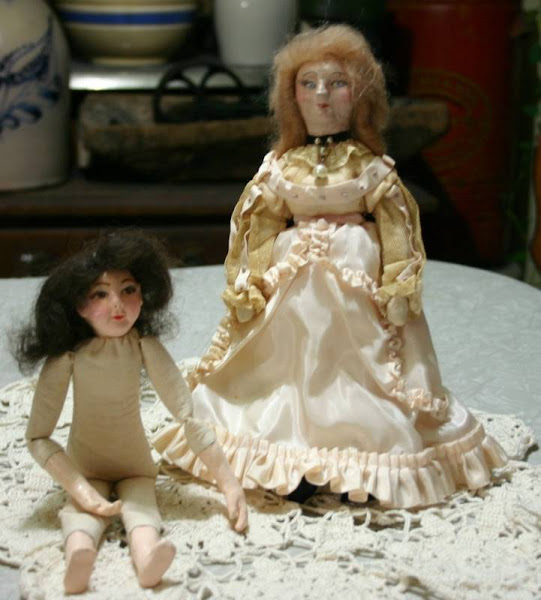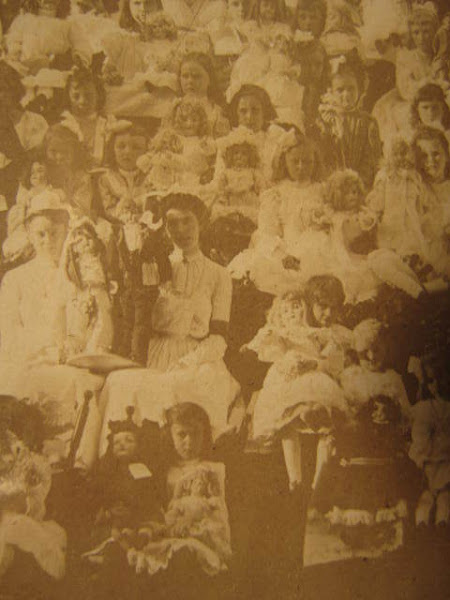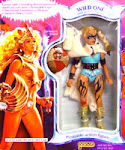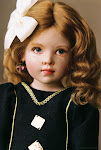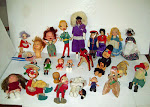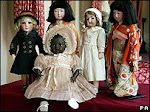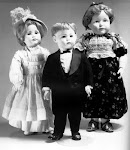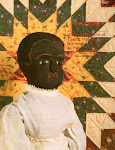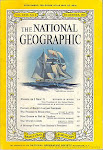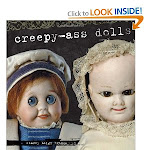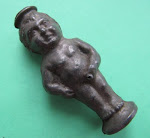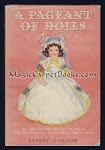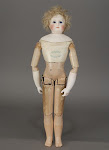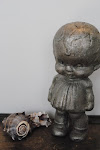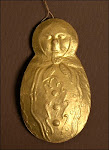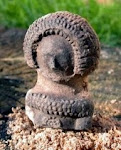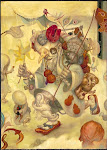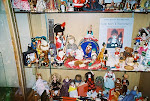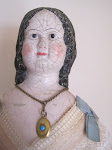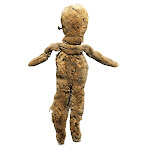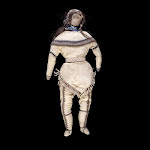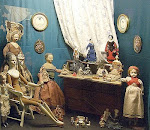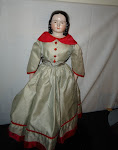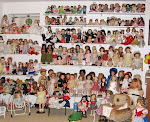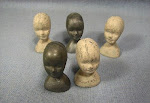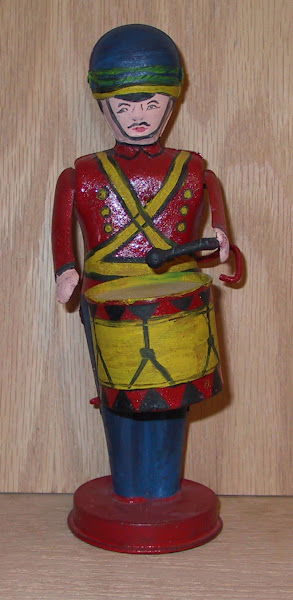Monday, June 30, 2014
"Never Stop to Think . . . Do I have a Place for This"
By Mary Randolph Carter, author of American Junk, Garden Junk, Kitchen Junk, etc.:
"Hoarding and collecting are two different thing--hoarding is a disease."
"If there's a place for it in your head, there's a place for it in your home."
Monday, June 23, 2014
If you want to Sell Dolls; More at Doll Collecting @ About.com
 I am not a dealer, nor do I sell dolls. I write about the dolls in my collection, and am creating a museum collection and inventory as my retirement project. Yet, many still ask me for my opinions and ideas about selling dolls. So, here are some tips from an amateur. There are more articles at my site at About.com. There will be four separate articles published after July 1, but here is a start:
YouTube.com: One day soon I plan a post on my favorite channels with dolls. Some of these are done by stores like Gigi's Dolls and Sherry's Teddies and other businesses that sell dolls.
Antique malls: You can rent a booth to sell your dolls. The rate is usually monthly. Sometimes you have to work a day or so a week at the mall if you have a booth there. It is usually up to you to maintain your displays. Sometimes, a percentage of sales may also go to the antique mall. There don't seem to be as many malls as there used to be. Some also feature eBay stores and online sites for buying and selling dolls.
Antique shops: Many buy all types of dolls for their inventory. Call and ask for the owner. A dealer will offer about 40-50% of the doll's value because s/he must be able to sell the doll and make a profit to stay in business.
Keep them: Not everyone is a collector, and not everyone wants to keep dolls. But, if they are family dolls and you like them, you may want to keep them awhile, and perhaps pass them on to another collector in your family.
Denise's articles: Review Denise's earlier articles on doll auctions, selling dolls, and caring for dolls. She has a lot of ideas, and used to run a doll shop. She still sells online and has written a great price guide.
Denise's blogs: Denise is writing her own blog about dolls.
Inventory: Always keep an inventory of the dolls that you have sold or intend to sell and update it. If you are computer savvy, there are great software programs to help you. Preferably, keep photos as well.
Price guides: Consult Denise's pricguides online, or look at Dollreference.com or other sites. Get a good book like Denise's Official Price Guide to doll or other guides by Patsy Moyer, Pat Smith, Linda Edward, or Jan Foulke.
Selling to upgrade: Some collectors gather dolls to sell so they can buy better dolls for themselves. Others sell to upgrade. They might buy a damaged German bisque doll and restore it, then, when they find a better example, they will sell that doll and "trade UP' to buy the example in better condition.
Selling to change collection focus: Some collectors sell to change the focus of their collection. Maybe they had antiques, and wanted to get into artists dolls. Or, they had vintage Barbies, and then decided they liked china heads. Years ago, Mrs. Lucretia Mott collect large antique dolls. She soon fell in love with miniatures and doll house dolls, sold the big dolls, and Mott's Miniature Museum was born. It stood for years within Knott's Berry Farm in California, and was one of my favorite places on earth.
I am not a dealer, nor do I sell dolls. I write about the dolls in my collection, and am creating a museum collection and inventory as my retirement project. Yet, many still ask me for my opinions and ideas about selling dolls. So, here are some tips from an amateur. There are more articles at my site at About.com. There will be four separate articles published after July 1, but here is a start:
YouTube.com: One day soon I plan a post on my favorite channels with dolls. Some of these are done by stores like Gigi's Dolls and Sherry's Teddies and other businesses that sell dolls.
Antique malls: You can rent a booth to sell your dolls. The rate is usually monthly. Sometimes you have to work a day or so a week at the mall if you have a booth there. It is usually up to you to maintain your displays. Sometimes, a percentage of sales may also go to the antique mall. There don't seem to be as many malls as there used to be. Some also feature eBay stores and online sites for buying and selling dolls.
Antique shops: Many buy all types of dolls for their inventory. Call and ask for the owner. A dealer will offer about 40-50% of the doll's value because s/he must be able to sell the doll and make a profit to stay in business.
Keep them: Not everyone is a collector, and not everyone wants to keep dolls. But, if they are family dolls and you like them, you may want to keep them awhile, and perhaps pass them on to another collector in your family.
Denise's articles: Review Denise's earlier articles on doll auctions, selling dolls, and caring for dolls. She has a lot of ideas, and used to run a doll shop. She still sells online and has written a great price guide.
Denise's blogs: Denise is writing her own blog about dolls.
Inventory: Always keep an inventory of the dolls that you have sold or intend to sell and update it. If you are computer savvy, there are great software programs to help you. Preferably, keep photos as well.
Price guides: Consult Denise's pricguides online, or look at Dollreference.com or other sites. Get a good book like Denise's Official Price Guide to doll or other guides by Patsy Moyer, Pat Smith, Linda Edward, or Jan Foulke.
Selling to upgrade: Some collectors gather dolls to sell so they can buy better dolls for themselves. Others sell to upgrade. They might buy a damaged German bisque doll and restore it, then, when they find a better example, they will sell that doll and "trade UP' to buy the example in better condition.
Selling to change collection focus: Some collectors sell to change the focus of their collection. Maybe they had antiques, and wanted to get into artists dolls. Or, they had vintage Barbies, and then decided they liked china heads. Years ago, Mrs. Lucretia Mott collect large antique dolls. She soon fell in love with miniatures and doll house dolls, sold the big dolls, and Mott's Miniature Museum was born. It stood for years within Knott's Berry Farm in California, and was one of my favorite places on earth.
Sunday, June 22, 2014
UFDC
 I could not have said it better myself, so I present here the announcement for our 65th Annual Convention. I first read about The United Federation of Doll Clubs in books written by Eleanor St. George. I was still in grade school, but could not wait until I grew up so I could join, and now, of course, I have.
I love the souvenir books that chronicle the convention, and I have my own sub collection of souvenir dolls. Denise, our former guide, has written many wonderful articles about her adventures with UFDC, and I personally appreciate their generous website with all the fantastic research information.
What better way to learn about dolls and doll history than through this august body of "plangonologists" or doll scholars?
Everyone involved is helpful and encouraging to novice collectors. There are many themed events with sourvenirs, the display rooms, the sales room, the camaraderie, and more. I love seeing who won what exhibits, and always get new ideas for my collections.
For those who do not know the history of the UFDC, here is a brief synopsis. The organization began in 1949 with 14 clubs. There are now over 500 clubs! Despite wars, bad economies, difficult times, and all sorts of other problems, doll collectors are a tough lot and we persevere! As my favorite author Barbara Pym put it, we members have found our passion in live, or our "something to Love."
UFDC headquarters is in Kansas City, and UFDC maintains its own museum. It's official publication is Doll News, an excellent magazine to which I have been lucky enough to contribute articles. Current editor Laurie McGill is doing a fabulous job! It's ReAL Services consist of archival libraries and other educational resources for those interested in any aspect of doll history and collecting. There is a Junior Collectors program, and the mascot is Miss Unity, patterned after an antique " Milliner's Model" or 1830s/40s papier mache.
San Antonio itself is packed with history and wonderful city. View The Alamo site if you get a chance. Surf the easy to navigate site for more, and try not to drool!!
See below, words in italics are those of the UFDC:
The 65th UFDC National Convention
“Shared Passions”
July 16th – 20th, 2014
Souvenir Doll Artist Dianna Effner
JW Marriott San Antonio Hill Country Resort
23808 Resort Parkway
San Antonio, Texas 78261
1-866-882-4420
jwsanantonio.com
View information about hotel reservations
Join us for an exciting experience sharing our passions for dolls with friends and family. Fun filled days of educational activities, superb salesroom, themed meal events and sightseeing opportunities combined with a relaxing atmosphere and Texas hospitality.
Convention Forms and Information
•Registration Information and Form
•Tentative Schedule Booklet
•Workshop Pictures
•Event Request Form, return by May 15, 2014
•At Your Service Open House Invitation
•Competitive Exhibit Booklet (Tentative)
•Competitive Exhibit Addition
•Antique Competitive Exhibit Entry Form, return by June 14, 2014
•Modern Competitive Exhibit Entry Form, return by June 14, 2014
•Golf Tournament Registration Form
•Helper Donation Mail-In Form, return by June 6, 2014.
•Pattern for the Bleuette Gathering, Tunic Blouse (Une Blouse Casaque)•Page 1
•Page 2
Convention 2014 Blog Posts
“Shared Passions” may be months away but our event artists are already hard at work. Each month UFDC is pleased to introduce you to the artists whose work will be showcased at the meal events planned for San Antonio and to share other helpful information about the convention.
•Convention 2014 Spotlight On Competitive Exhibits ~ We Need More Dolls!
•Convention 2014 Gatherings Spotlight
•Convention 2014 ~ Public Day
•Convention 2014 Artist Spotlight ~ Denis Bastien (Leeann’s Dad) of Affordable Designs – Canada
•Convention 2014 Artist Spotlight ~ Beverly Stoehr
•Convention 2014 Spotlight On Ticketed Meal Events
•Convention 2014 ~ Golf Tournament Fundraiser
•Convention 2014 Artist Spotlight ~ Dianna Effner
•Convention 2014 Hotel Information
•Convention 2014 Tours Spotlight
•Convention 2014 Artist Spotlight
I could not have said it better myself, so I present here the announcement for our 65th Annual Convention. I first read about The United Federation of Doll Clubs in books written by Eleanor St. George. I was still in grade school, but could not wait until I grew up so I could join, and now, of course, I have.
I love the souvenir books that chronicle the convention, and I have my own sub collection of souvenir dolls. Denise, our former guide, has written many wonderful articles about her adventures with UFDC, and I personally appreciate their generous website with all the fantastic research information.
What better way to learn about dolls and doll history than through this august body of "plangonologists" or doll scholars?
Everyone involved is helpful and encouraging to novice collectors. There are many themed events with sourvenirs, the display rooms, the sales room, the camaraderie, and more. I love seeing who won what exhibits, and always get new ideas for my collections.
For those who do not know the history of the UFDC, here is a brief synopsis. The organization began in 1949 with 14 clubs. There are now over 500 clubs! Despite wars, bad economies, difficult times, and all sorts of other problems, doll collectors are a tough lot and we persevere! As my favorite author Barbara Pym put it, we members have found our passion in live, or our "something to Love."
UFDC headquarters is in Kansas City, and UFDC maintains its own museum. It's official publication is Doll News, an excellent magazine to which I have been lucky enough to contribute articles. Current editor Laurie McGill is doing a fabulous job! It's ReAL Services consist of archival libraries and other educational resources for those interested in any aspect of doll history and collecting. There is a Junior Collectors program, and the mascot is Miss Unity, patterned after an antique " Milliner's Model" or 1830s/40s papier mache.
San Antonio itself is packed with history and wonderful city. View The Alamo site if you get a chance. Surf the easy to navigate site for more, and try not to drool!!
See below, words in italics are those of the UFDC:
The 65th UFDC National Convention
“Shared Passions”
July 16th – 20th, 2014
Souvenir Doll Artist Dianna Effner
JW Marriott San Antonio Hill Country Resort
23808 Resort Parkway
San Antonio, Texas 78261
1-866-882-4420
jwsanantonio.com
View information about hotel reservations
Join us for an exciting experience sharing our passions for dolls with friends and family. Fun filled days of educational activities, superb salesroom, themed meal events and sightseeing opportunities combined with a relaxing atmosphere and Texas hospitality.
Convention Forms and Information
•Registration Information and Form
•Tentative Schedule Booklet
•Workshop Pictures
•Event Request Form, return by May 15, 2014
•At Your Service Open House Invitation
•Competitive Exhibit Booklet (Tentative)
•Competitive Exhibit Addition
•Antique Competitive Exhibit Entry Form, return by June 14, 2014
•Modern Competitive Exhibit Entry Form, return by June 14, 2014
•Golf Tournament Registration Form
•Helper Donation Mail-In Form, return by June 6, 2014.
•Pattern for the Bleuette Gathering, Tunic Blouse (Une Blouse Casaque)•Page 1
•Page 2
Convention 2014 Blog Posts
“Shared Passions” may be months away but our event artists are already hard at work. Each month UFDC is pleased to introduce you to the artists whose work will be showcased at the meal events planned for San Antonio and to share other helpful information about the convention.
•Convention 2014 Spotlight On Competitive Exhibits ~ We Need More Dolls!
•Convention 2014 Gatherings Spotlight
•Convention 2014 ~ Public Day
•Convention 2014 Artist Spotlight ~ Denis Bastien (Leeann’s Dad) of Affordable Designs – Canada
•Convention 2014 Artist Spotlight ~ Beverly Stoehr
•Convention 2014 Spotlight On Ticketed Meal Events
•Convention 2014 ~ Golf Tournament Fundraiser
•Convention 2014 Artist Spotlight ~ Dianna Effner
•Convention 2014 Hotel Information
•Convention 2014 Tours Spotlight
•Convention 2014 Artist Spotlight
Retailing with Dolls from Someone who Doesn't really Sell !
Sunday, June 15, 2014
An Apologia for Countess Erzebet Bathory: Prince Lestat
An Apologia for Countess Erzebet Bathory: Prince Lestat: For those who love the Vampire angle, take heart! "Prince Lestat" is due this October, and according to Anne Rice, "Lestat&#...
Friday, June 13, 2014
Thursday, June 12, 2014
Tuesday, June 10, 2014
Firsts in My Collection
My first doll: My first doll was a squeaky baby doll dressed in bunny jammies. He is yellow. I was under a year old, and he came from Greece, along with me. We have a photo of me at about 9 months where I'm sitting next to a beautiful black doll, a little girl in an organdy dress. Unfortunately, the doll was a photographer's prop.
My first Nancy Ann Storybook Doll: Mrs. G., my grandmother's friend, watched me for kindergarten and first grade before and after school because both my parents worked. Her daughter had left her doll collection behind when she moved to California. Some were in a small glass case in her living room. I used to look at them for hours. Mrs. G. used to tell me their stories, and it turns out, there was a trunk full of dolls in her cellar, along with the old ringer washing machine. When she moved to California herself, she gave me one of her daughter's Nancy Ann Storybook dolls, a bridesmaid in a yellow chiffon dress, one piece body, brown hair, and jointed arms. She also gave a toy ringer washing machine and refrigerator, all cherished items in my collection today.
My first Talking Doll: This was, of course, Chatty Cathy, but I also got the Chatty Baby twins my 4th Christmas. I have several of them now; can't seem to resist them, as well as a couple of Cathy's outfits. One belonged to the collection of the Bussey Doll Museum.
My first Barbie: Dad took me to Turnstyle when I was barely five and bought me the Champagne pink gift set with the blonde bubble cut Barbie. I still love her, and I have to say, these vintage dolls and their wardrobes remind me of my Mom and how she used to dress to go to teach school in those days.
My first antique doll: My first antique was a three inch Frozen Charlotte of glazed china with black hair. She came from the old Women's Club antique show. She has her own wardrobe, handmade bedding, and a gold sled. Sometimes, she resides in the red doll house my dad named for me, known as Plantagenet House, and usually, she resides in a small glass case with other tiny antiques.
My first Frozen Charlotte: See above!
My first antique china head: I found her at an antique show held in a Masonic Temple that isn't there anymore. She is five inches long, and is the black "low brow" hairstyle. She had her original cloth body, hands, and feet and original underwear. My mom made her a gown of yellow cotton and eyelet that she wears to this day.
My first German Bisque [Melinda]: She came from the same antique show as my first china head. I think the same dealer had her. There was a lot of back and forth going on that weekend. Melinda cost $13.50 when all was said and one, the little china head $5.00. It was beyond my allowance at that point. But, Melinda, masquerading as a Dutch Boy, came home. She had a brown mohair wig, and is probably a Heubach Kopplesdorf head, though I though she was a small A & M 390 for a long time. She has black inset eyes that don't sleep, a five piece composition and papier mache body, and an open mouth with teeth. She wears a dainty blue and white lace dress these days and goes with me everywhere.
My first Raggedy Ann: Ann was a Knickerbocker model, about 14 inches long. Andy soon followed. My grandma made her other dresses to wear with her white pinafore. She is very cute and is another doll that went everywhere with me. She and her brother came from the oldest department store in our area, bounded in 1872.
My first French Fashion Doll: She is a ten inch Barrois wearing a white dotted Swiss dress. her pink ribbons and blond wig have faded. Her body is kid with separately stitched fingers on her hand. She doesn't have shoes yet. I bought her from the booth of the legendary Jim Fernando and his pals. They even found a French bag to put her in. I kept it with her. I've collected many accessories for her over the years, including trunks, a corset, toiletries, jewelry, other shoes, fans, and more.
My first Shirley Temple: We didn't know what she was. She cost $4.00 in 1970 and came from an antique store called Lighthouse Antiques, an old open air market on the banks of The Mississippi. The family that owned it lived in part of the building. She was dirty, and her curls were limp. We took her home and started cleaning her up. My mom turned her over to try to do something with her hair, and then we saw the marks for "Ideal" and "Shirley Temple." We went ballistic in a good way.
My first Madame Alexander [Ecuador]: She is one of the 8 inch internationals, Ecuador. I was barely in Kindergarten, and she came from a department store found in 1872 and still in operation. She has been loved, her hair braided, her close washed, many times. She has held up with dignity. I learned about countries in South American because of her.
My first Ningyo: She is a well loved Geisha named Miss Flower after Rumer Godden's heroine. She is off her stand these days, and has lost her hat. She is about 11 inches, and has a bright, red-patterned Kimono. She carried a branch of cherry blossoms. She has more than 300 sisters today, including Festival dolls, and some Friendship-type dolls. But, she is family, and still a favorite.
My first Beanie Baby: Tabasco the bull; he was my mom's favorite, and he actually arrived home as a birthday present for her. This was before the madness, and I walked to the shop from my office downtown in snow, ice, and below twenty degree weather. Little did we know what was coming.
These are a few "firsts" that took place in my doll collection. I'd like to hear from my readers what some of yours were, and we can compile them into a post for everyone.
Doll Museum: The 19th Century Continued: A Chronology of Types...
Doll Museum: The 19th Century Continued: A Chronology of Types...: This list was originally compiled by Madeline Merrill in "The Art of Dolls: 1700-1940." This book was published in 1985 by the Ho...
Saturday, June 7, 2014
12 Display Tips for your Dolls; a Guest Post
Our guest blogger is Kristin McWharter of Theriault's, the famous doll auction company. This is an illustrated piece, with wonderful photos, all courtesy of Theriault's.com.
Displaying dolls can be one of the most rewarding and most challenging aspects to collecting. A creative and engaging display draws viewers in and transforms an otherwise overlooked doll into a true treasure. Here are 12 tips on how to leave a lasting impression with a display that showcases the best assets of your collection.
1. Tell a story
The most dynamic and interesting displays are those that tell a story in the minds of their viewers. Start with a theme. Whether it’s a holiday, a color palette, or a certain feeling, find a narrative that takes your display a step further. Choosing your dolls and accessories based on the story you want them to tell breathes new life into your collection, and keeps your viewer engaged.
2. Create Levels
Before you begin arranging your dolls, make a note of where eye level is, usually around 5ft. This is where your viewer is most naturally inclined to focus their attention and will emphasize key details. Then build your display with a variety of heights and depths, keeping your main focal points around eye level. By doing this, you allow the viewer’s eye to move around the room, making your display more dynamic, while still showcasing what’s important. Pyramids made of props and pedestals work great, as do vertically stacking shelves and display cabinets.
3. Keep it clean
You don’t want to clutter your display; remember less is more. Too many objects can be visually difficult to read and your items can get lost (defeating the purpose of displaying them in the first place). If you have a large number of dolls and objects, simplify your design by organizing them based on size or color. Create small “vignettes” or focal points that allow your viewer to focus in on a few dolls rather than find themselves overwhelmed.
4. Focal points and patterns
As viewers we are attracted to pattern, so use it to your advantage while creating your displays. Dolls and objects of similar colors, shapes, and sizes can be arranged to move the eye around the room or to emphasize a certain focal point. Play with asymmetry and irregularity to highlight certain items. For example, grouping many red objects alongside one blue object will fix the eye upon the object that is breaking the pattern, making the blue item particularly noticeable to the viewer. Patterns also give your display an overall sense of aesthetic design and appeal.
5. Be bold
Avoid the predictable. Incorporate unexpected items and contrasting colors to create a sense of whimsy in your display. Small visual surprises make your design entertaining and draw the viewer in. Have an area that’s a bit boring? Add a bouquet of silk flowers or an oversized prop to make it more interesting.
6. Strike a pose
They are dolls after all. Don’t be afraid of posing them with a little personality!
7. What are your dolls looking at?
What direction your dolls are facing can be just as important as where you place them. Imagine that every doll you have displayed is angled to be facing a certain corner of the room. Suddenly that corner becomes a character in your display as viewers turn to see what all the dolls are staring at! Use the glance of your dolls to your advantage to highlight a focal point, create pattern, or emphasize your theme.
8. Incorporate a backdrop
The color of your wall might not be the best color or texture to accent your display. Incorporating a backdrop can be a useful tool to add drama and cohesion to your design. Hanging colored paper or a panel of fabric can be a quick and easy way to create an environment for your dolls. You can even place a painting or poster behind your dolls to create a sense of landscape and mise en scene!
9. Domes and Display Cabinets
Not only are they protective, but domes and display cabinets can be a great opportunity to give smaller dolls the attention they deserve. Isolate a few dolls within their own mini display scene, and observe how small gestures and details can really stand out within a larger display and feel truly magical.
10. Remember your theme
It’s easy to get distracted by small details or get carried away on a tangent, so take a moment to remember your theme. A clear and concise story makes your display more engaging and is a great strategy to prevent your design from becoming too cluttered or overwhelming. Every now and then take a step back and look at your display from a distance. Is your theme clear? Does it grab your attention? Don’t be afraid to go back and change what’s not working.
11. Let there be light
Good lighting can be one of the best ways to make your dolls really stand out. Highlight your best dolls and objects using spotlighting, or create a special tone and ambiance by incorporating a soft colored light. With so many fixtures and bulbs available, the possibilities are plentiful. However, not taking light into consideration could result in unattractive shadows, or worse, fading. Protect your dolls from bright windows and light sources that could be harmful, and instead control the lighting to showcase their best features.
12. Be creative
Let your imagination run wild. Building displays can be one of the most fun and rewarding aspects of collecting. Change your displays every few months to try out new ideas and spotlight different dolls. Move things around, experiment, try something different, and most importantly, have fun.
Founded in 1970 Theriault’s specializes exclusively in the appraisal and auction of antique dolls and childhood ephemera. The firm's offices and cataloging center are headquartered in Annapolis, Maryland, and the company hosts live auctions in major cities throughout the United States.
For more information please visit www.Theriaults.com
Sunday, June 1, 2014
Mass Produced Bisque, China and Porcelain Dolls
So, why bother to include modern, mass produced bisque dolls in your collection? In fact, why bother to collect reproductions at all? I know from trying to set up an estate sale for someone that most dealers do not want to handle these dolls, and they price them very low when they do get them, far less than the doll sold for originally. Price guides are just now to include them, but they're usually Franklin mint dolls not made anymore, or Shackman dolls, which have their own following by now.
A recent grouping at yard sale, from ten to sixteen inches, was selling from $3.00-5.00 each doll. Originally, they cost from $8.00 to $20.00. These did not have their boxes. Most were dressed in red velvet as Christmas dolls, and there were about 8 dolls total. I confess I bought a couple because they were too cute to leave. I always say my collection runs from the sublime to the ridiculous, so I can include a few dolls like this to compare to antique dolls and artist renditions.
My premise is that collecting is not about money, and I think others, even those in the auction business, have echoed that sentiment. If you like it, and it makes you happy, collect it. Display it proudly, care for it. My next point is, that as Genevieve Angione wrote, "All Dolls are Collectible." Barbie, hard plastic dolls, vinyl and modern dolls of types, half dolls and metal heads were once considered secondaries, or well, "junk." Just look at "The Complete Book of Doll Making and Collecting" by veteran author and doll artists, Helen Young. Not so anymore. These modern porcelain dolls are not made as much any more. They are as ephemeral as paper dolls because they are disposed of so often. They are also a piece of doll history, a stepping stone that bridges trend sin collecting and illustrate the craze for porcelain dolls. Waldas are also a good way to introduce younger people to collecting dolls, and are fun to create wardrobes for. In fact, about 15 years ago, craft stores like JoAnn Fabrics and the now defunct So Fro Fabrics sold undressed models of these dolls so wardrobes could be created for them.
Now, the craze, of course, is ball-jointed dolls. In time, they took, will fall out of favor and end up at Goodwill. I've watched this happen with Beanie Babies, Cabbage Patch Kids, Tickle-Me-Elmos, Furbies, even the odd American Girl. After a while, the craze passes, and they are consigned to a yard sale. Yet, for collectors, these dolls and toys have some intrinsic value. As proof, read Laurie McGill's excellent article on Elizabeth Ann Coleman and her legendary family's doll collection in the current "Doll News." There are mermaid Barbies along with hard plastic forties dolls displayed, and row after row of antique bisques and chinas. The antiques were once "throwaway" items, too, for the most part. It was their appeal and "cuteness" that made people save then, or literally rescue them from dump sites. The same will be true of modern porcelain dolls or Waldas. Waldas can be lovely, and they explain trends in collecting. No, they won't hit the record price of an A. Marque or a good Jumeau, even, but if you want an A. Marque, look for the version made by Dynasty dolls. It will cost you un der $100, and you won't have to mortgage your house.
Happy collecting!
Subscribe to:
Posts (Atom)
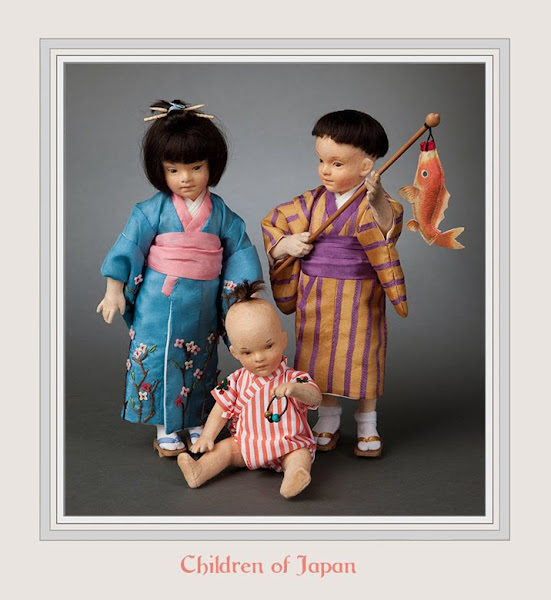

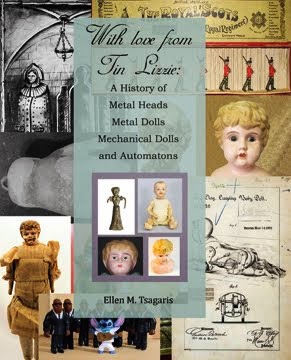
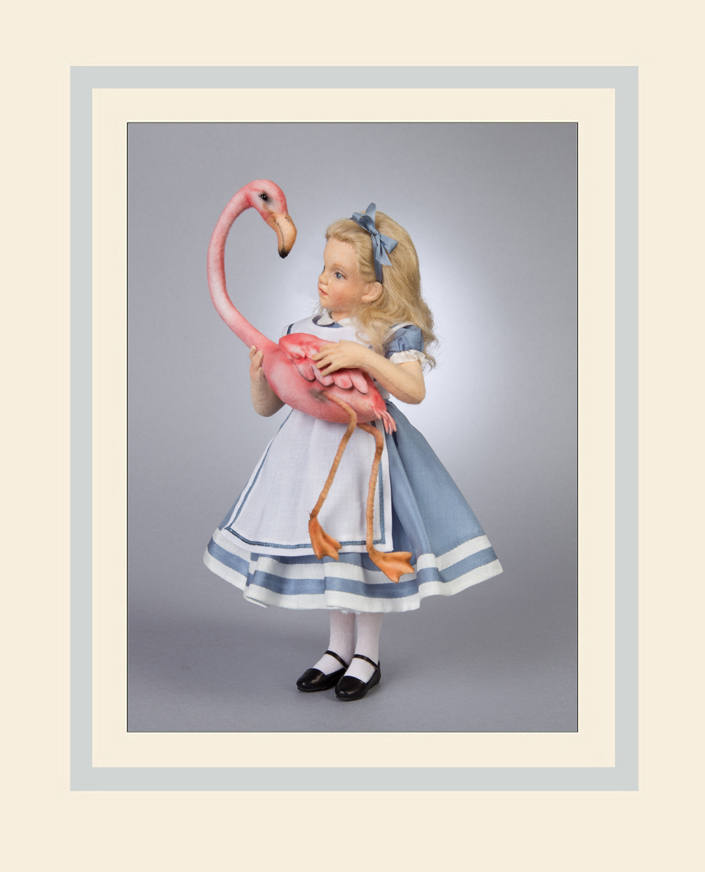


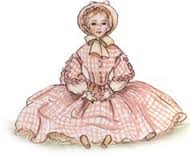


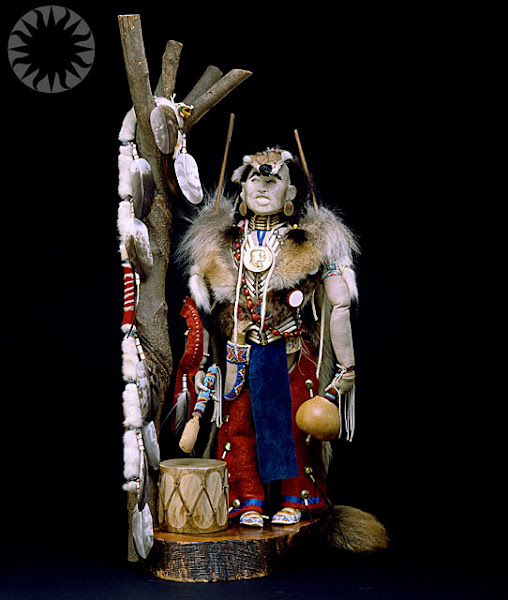
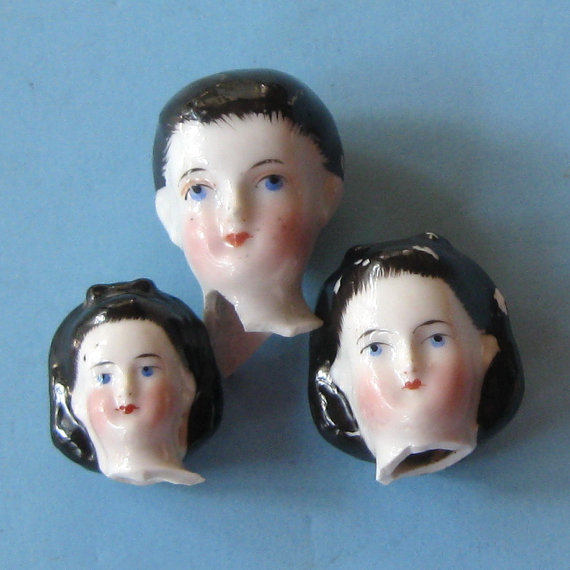
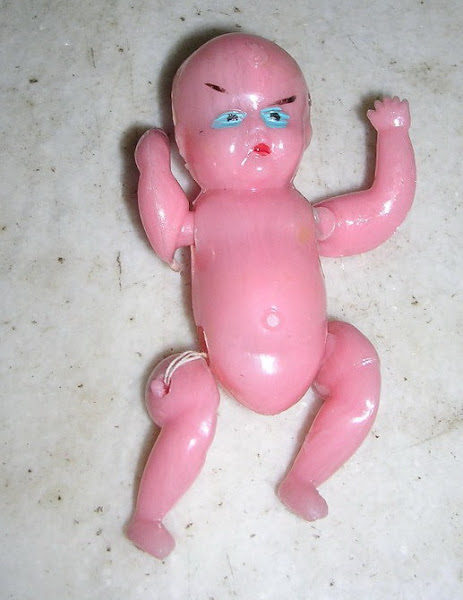
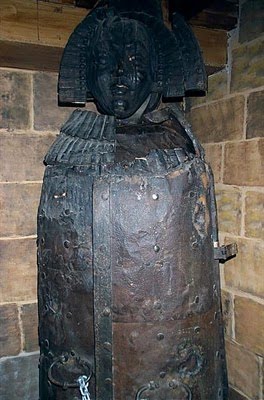

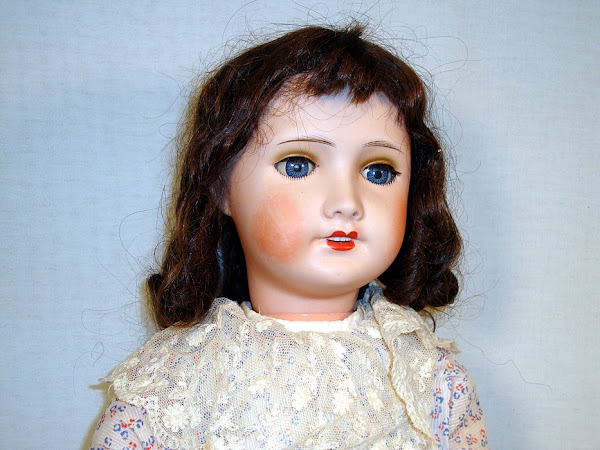



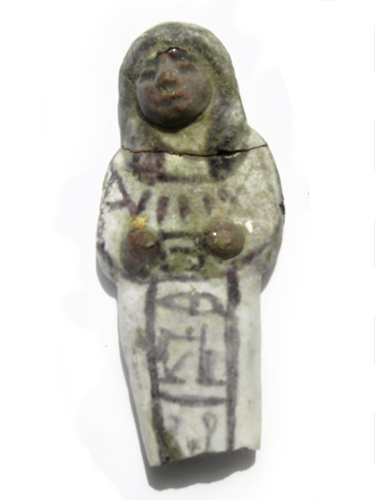
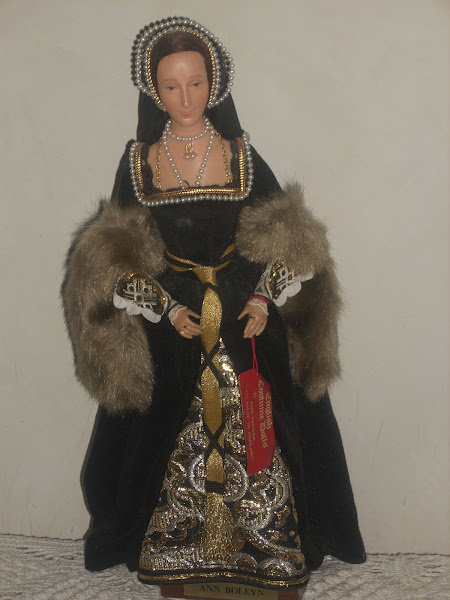





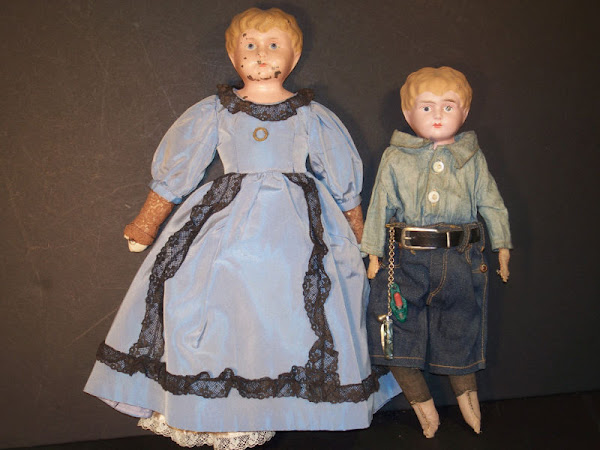


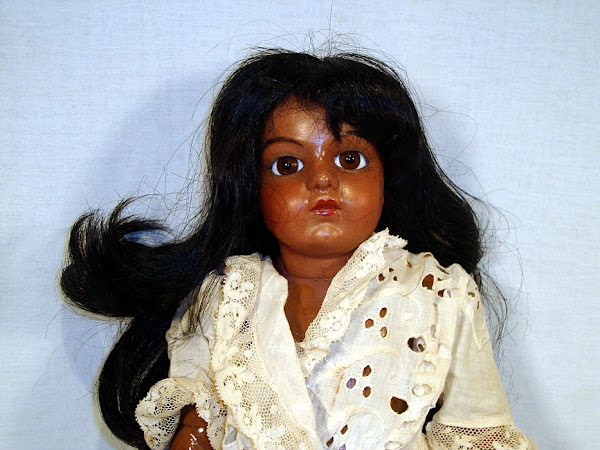
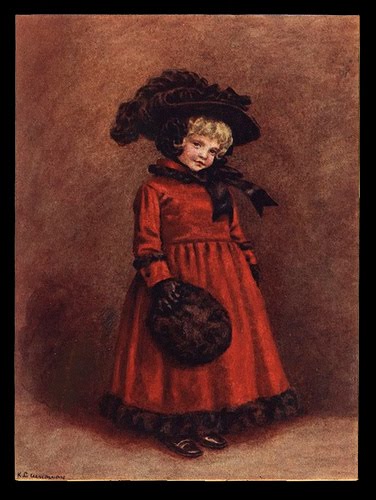

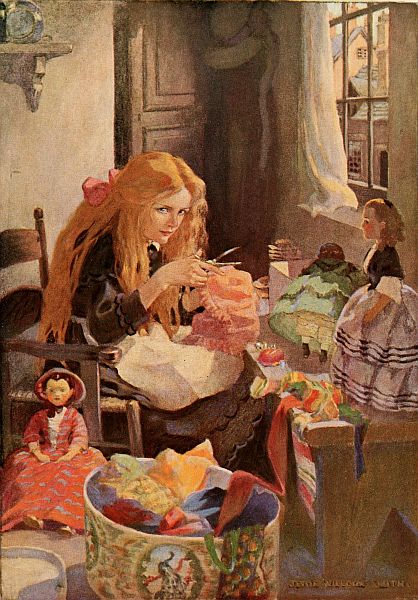


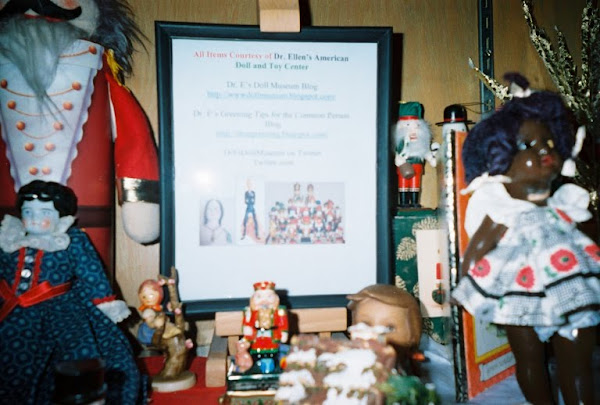






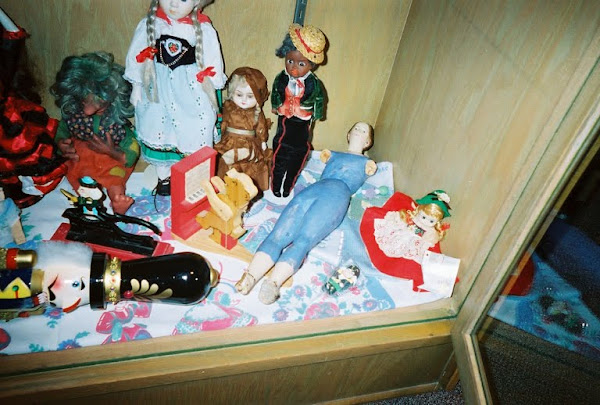
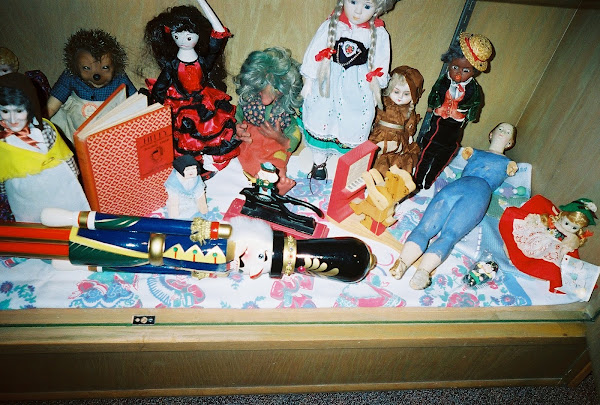
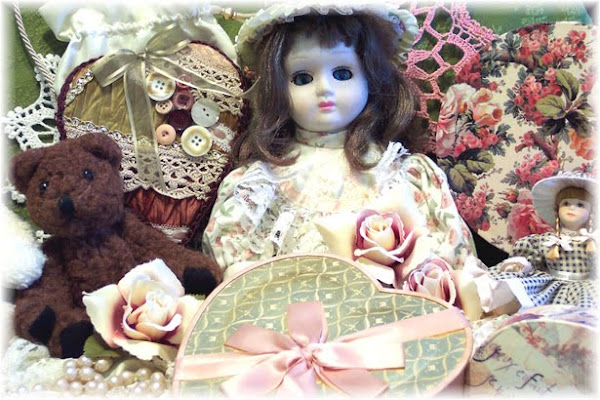
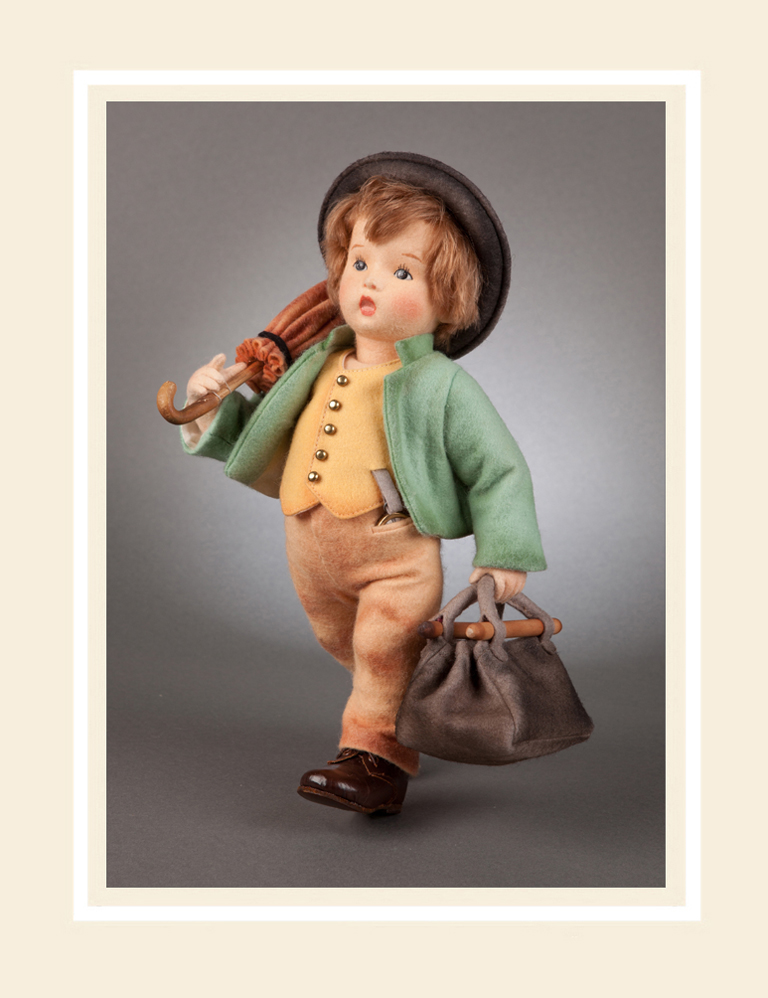

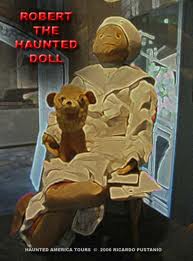

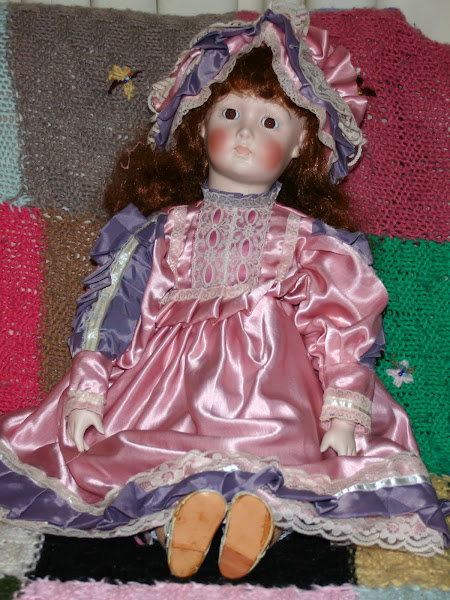
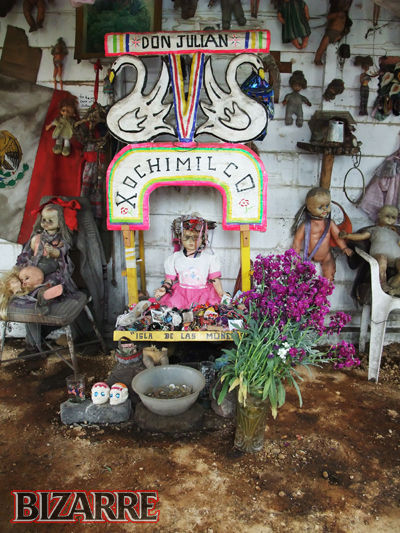
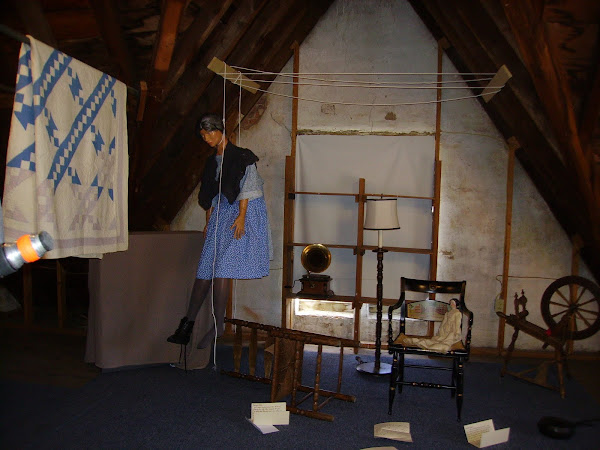
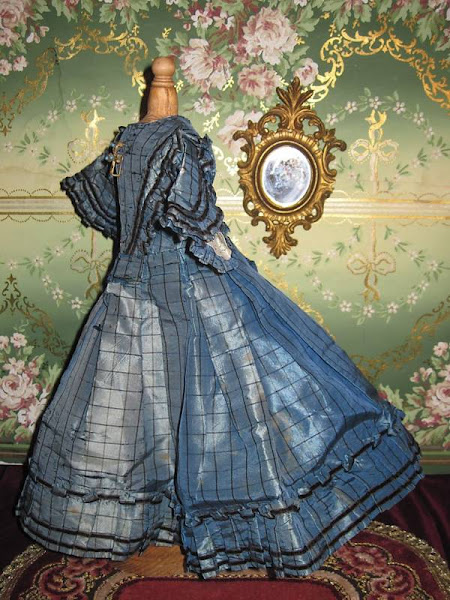wCWk~%24(KGrHqV,!h8Ew5GsnS3dBMUy3MzVPg~~_3.jpg)


